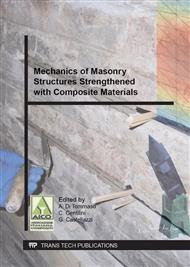[1]
S. De Santis, G. de Felice, Tensile behaviour of mortar-based composites for externally bonded reinforcement of masonry. Submitted to Compos. B-Eng. (2014).
DOI: 10.1016/j.compositesb.2014.09.011
Google Scholar
[2]
A. D'Ambrisi, L. Feo, F. Focacci, Experimental and analytical investigation on bond between Carbon-FRCM materials and masonry, Compos. B-Eng. 46 (2013) 15-20.
DOI: 10.1016/j.compositesb.2012.10.018
Google Scholar
[3]
G. de Felice, S. De Santis, L. Garmendia, B. Ghiassi, P. Larrinaga, P.B. Lourenço, D.V. Oliveira, F. Paolacci, C.G. Papanicolaou, Mortar-based systems for externally bonded strengthening of masonry. Mater. Struct. (2014). To appear.
DOI: 10.1617/s11527-014-0360-1
Google Scholar
[4]
F. Parisi, I. Iovinella, A. Balsamo, N. Augenti, A. Prota, In-plane behaviour of tuff masonry strengthened with inorganic matrix–grid composites, Compos. B-Eng. 45 (2013) 1657-1666.
DOI: 10.1016/j.compositesb.2012.09.068
Google Scholar
[5]
M.R. Valluzzi, C. Modena, G. de Felice, Current practice and open issues in strengthening historical buildings with composites, Mater. Struct. (2014). To appear.
DOI: 10.1617/s11527-014-0359-7
Google Scholar
[6]
A. Borri, G. Castori, M. Corradi, Shear behavior of masonry panels strengthened by high strength steel cords, Constr. Build. Mater. 25 (2011) 494-503.
DOI: 10.1016/j.conbuildmat.2010.05.014
Google Scholar
[7]
T.C. Triantafillou, C.G. Papanicolaou, Innovative applications of textile-based composites in strengthening and seismic retrofitting as well as in the prefabrication of new structures, Adv. Mater. Res. 639-640 (2013) 26-41.
DOI: 10.4028/www.scientific.net/amr.639-640.26
Google Scholar
[8]
CNR-DT 200 R1/2012. Guide for the Design and Construction of Externally Bonded FRP Systems for Strengthening Existing Structures. Italian Research Council, Italy (2012).
Google Scholar
[9]
AC434. Proposed acceptance criteria for masonry and concrete strengthening using fiber-reinforced cementitious matrix (FRCM) composite systems. ICC-Evaluation Service, Whittier, CA (2013).
DOI: 10.14359/51702356
Google Scholar
[10]
I.G. Colombo, A. Magri, G. Zani, M. Colombo, M. di Prisco, Textile Reinforced Concrete: experimental investigation on design parameters, Mater. Struct. 46 (2013) 1933-(1951).
DOI: 10.1617/s11527-013-0017-5
Google Scholar
[11]
A. Paul, Chemical durability of glasses: a thermodynamic approach, J. Mater. Sci. 12 (1977) 2246-2268.
DOI: 10.1007/bf00552247
Google Scholar
[12]
A.J. Majumdar, J.M. West, L.J. Larner, Properties of glass fibres in cement environment. J. Mater. Sci. 12 (1977) 927-936.
DOI: 10.1007/bf00540975
Google Scholar
[13]
W. Brameshuber (ed) Textile reinforced concrete. State-of-the-Art Report of RILEM Technical Committee 201-TRC, RILEM Report 36, RILEM Publications S.A.R.L. (2006).
DOI: 10.1617/2351580087.00a
Google Scholar
[14]
J. Orlowsky, M. Raupach, Modelling the loss in strength of AR-glass fibres in textile-reinforced concrete. Mater. Struct. 39 (2006) 635-643.
DOI: 10.1617/s11527-006-9100-5
Google Scholar
[15]
U. Häußler-Combe, J. Hartig, Bond and failure mechanisms of textile reinforced concrete (TRC) under uniaxial tensile loading, Cem. Concr. Compos. 29 (2007) 279-289.
DOI: 10.1016/j.cemconcomp.2006.12.012
Google Scholar
[16]
B. Mobasher, A. Peled, J. Pahilajani, Distributed cracking and stiffness degradation in fabric-cement composites, Mater. Struct. 39 (2006) 317-331.
DOI: 10.1007/s11527-005-9005-8
Google Scholar


